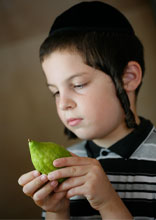In I got It!
An Esrog from the Garden of Eden
The most accepted opinion among Chazal as to the identity of the Tree of Knowledge that stood in the Garden of Eden is that it was an esrog tree, in contrast to the widespread myth, that originates in christian belief, that the tree was one that grew apples.
This is the opinion of Rav Abba of Akko; “It was an esrog [tree], as it states – ‘and the woman saw that the tree was good to eat’ [Bereishis chapter 3 verse 6] – and which tree is it whose bark is eaten as is its fruit? – there is none other apart from the esrog tree.” (Bereishis Rabbah 15)
Rav Abba established that the simple meaning of the words ‘the tree was good to eat’ indicate that the characteristics of the fruit were contained also in the bark itself, and it has already been established that only the esrog tree has these properties. Therefore, the eitz ha’daas is none other than the esrog tree, from which Adam haRishon and Chava ate, despite the explicit commandment from HaShem that they were not to do so.
Chazal also bring other opinions as to the identity of the eitz ha’daas:
According to the view of Rav Meir, the tree was a grape-vine; “since there is nothing that brings tragedy upon man more than wine, as it says – ‘and he partook of the wine, and became intoxicated.’ (Bereishis chapter 9 verse 21)
According to the view of Rav Nechemia, it was a fig tree; “since the very object of their corruption later served for their rectification, as it says – ‘and they sewed for themselves fig leaves.’ (Bereishis chapter 3 verse 7)
And according to the view of Rav Yehudah, it was a wheat-stalk; “since a baby does not know how say the words ‘father’ or ‘mother’ until he tastes grain.” (Maseches Brochos, daf 40 amud alef)
According to the view of the Ben Ish Chai (Rabbeinu Yosef Chaim of Baghdad, 27th Av 5594 – 13th Ellul 5669), the essence of the eitz ha’daas incorporated the properties of all these various different fruits, and he thus resolved the contradictions between the opinions of Chazal.
The myth that the eitz ha’daas was an apple tree originates with the christians, but unfortunately, it has also insinuated its way into Jewish folklore, although it has absolutely no basis in any of the Jewish source and only serves to mislead many.







